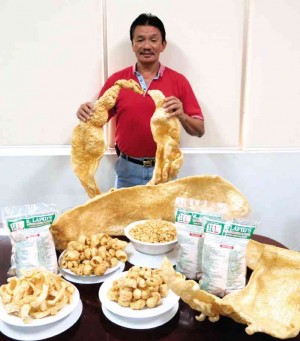
A picture of a giant chicharon shown to me by Dimple Lim led to a trip to the R. Lapid plant in Valenzuela last week.
“Chicharon King” Rey C. Lapid is one of those people who chase their dreams, stopping at nothing to make them come true.
He is unassuming, even shy, yet with a quiet confidence that only someone who has worked his way to the top could exude. He says R. Lapid’s Chicharon now has a hundred outlets and is expanding overseas.
Pork skin
Rey remembers dreaming of making chicharon on his own when he was 12 years old. During school breaks in summer he would wake up at 5 a.m. to go with his father, Federico J. Lapid, who had a meat stall at Quinta Market.
“Many of our customers, after paying for the (pork) meat, asked us to remove the skin, which we discarded as waste,” Rey recalls, adding that he asked his father if he could have the skin. He would eventually go around the market asking for the pork skin from other vendors.
One Sunday, his father opened the refrigerator and was shocked to find it stocked with all the rinds he had gathered.
From there his dad started making chicharon to be sold at the family stall in Quinta.
The mission
In 1974 Rey started his own business, R. Lapid’s Chicharon and Barbecue, at a small stall along R. Hidalgo Street in Quiapo. Rey and his wife Violeta sold chicken barbecue, longganisa, tocino and chicharon.
Later on he went to America, venturing into the restaurant business which he wasn’t familiar with. He realized that he bit off more than he could chew.
He came back to the Philippines in 1986, eager to start anew. He adopted new methods and technology to improve his chicharon.
Thus was born R. Lapid’s slogan, “Laging Bagong Luto”—the mission was to serve crispy, newly cooked chicharon at its best, all the time. To further enhance the experience, he also reconcocted the vinegar that went with it.
Rey considers his chicharon more than just snack food. “Ulam siya,” he says.
Though the brand has earned many awards, Rey swears he still goes to the plant every day, manning the operations.
The secret to his success, he says, is no secret at all: “We maintain the highest quality of ingredients and constantly search for better ways to improve the way we process, cook and package our products… Further, we treat our employees as family.”
He says never in his wildest dreams did he think that his food shop would attain the success it now enjoys: “I still pinch and ask myself, if this is all real.”
Personal favorites
Giant Chicharon: Handpicked large, uncut pork skin. It requires delicate handling and gradual cooking for it to puff to perfection, to produce chicharon that’s delicate, airy, crisp and tasty.
Like most of R. Lapid’s Chicharon, this is available in plain, chili and super chili flavors. By order and pickup only. Allow two days lead time for your orders, for pickup at the R. Lapid’s branch nearest you. Having it at your appetizer table gives your guests much to munch and talk about. A real fun party food!
Chicharon with Laman: Fresh, high-quality imported pork skin with fat and meat delicately cooked crisp in pork oil that Rey says he himself makes for this chicharon to be tastier. I love this chopped coarsely with munggo or champorado.
Chicharon with Special Laman: A new type of chicharon made from the highest quality imported fresh pork loin with fat and much thicker meat. It makes for a heavy snack. It can also be eaten with rice, added to binagoongang baboy, or coarsely chopped and sautéed with bagoong.
Manila Fries: Made from pork skin without the fat and meat. This is what I like to call “chicha-corn.” These chicharon bits are as addicting as “cornicks.”
For orders, call R. Lapid’s at tel. nos. 4433083 to 84 and 4567131.
Chicharon with ‘achara’
I enjoy chicharon best with good achara, specifically acharang Calaca. Here’s a recipe from Dindo Montenegro from my Taal Culinary Tour days.
Achara should have the right mix of sweetness, sourness and saltiness—or adjust accordingly to what suits your taste.
Acharang Calaca
1 k young green papaya, shredded (other possible ingredients are ubod ng niyog, labong ng kawayan and ampalaya)
½ c salt
Combine the grated papaya with salt and toss them together.
Leave it for 30 minutes.
With a clean piece of cloth, start squeezing the papaya to extract all the liquid. You may sun-dry the papaya for three hours to further take away the moisture.
Pickling solution
½ c ginger (thin slices)
2 tbsp fresh turmeric
4 cloves native garlic, sliced thin
1½ c light brown sugar
1 pc medium-size red and green bell pepper (cut in fancy shapes for garnish)
1½ L vinegar (native sukang irok/kaong)
Bring vinegar to a boil, and add sugar.
Add ginger and garlic.
Check seasoning.
Cool.
Strain.
Add papaya, peppers and carrots.
Let sit overnight.
Serve with chicharon.
Using the right vinegar, in this case sukang irok, makes all the difference.
For achara or sukang irok orders, call Dindo Montenegro at tel. 0916-5522074.
For a copy of my new cooking class schedule, call tel. nos. 9289296, 4008496, 0908-2372346 and 0917-5543700.